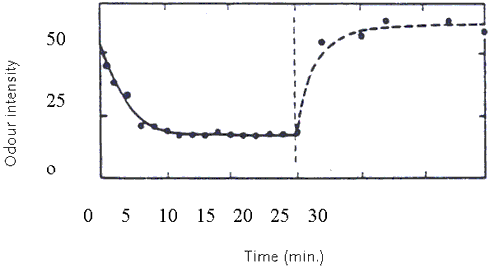Industrial odour control
3 Perception of smell
| 3.1 | Olfactory sense |
| 3.2 | Description of smells |
| 3.3 | Special aspects of the perception of smell |
3.1 Olfactory sense
The olfactory sense works with sensory cells in the upper nasal cavity and sensory threads all over the nasal mucosa. The impression of smell is the result of a chemical effect on sensory cells in the upper nasal cavity. When sensory threads are activated we get the characteristic pricking sensation known from acid vapours. This type of smell is biologically speaking very different from the perception of smell as such. The pricking sensation is only released at concentrations so high that normally there would be other problems than the mere smell impact. This impact need not be considered when dealing with environmental problems caused by odour.
The region of the mucosa that releases the impression of smell, is placed in the upper nasal cavity. By normal breathing only small quantities of the inspired air passes this region. Sniffing can temporarily increase the sensitivity of the olfactory process. The sensation of smell thus depends on the passage of air through the nose.
3.2 Description of smells
The extent of the smell impact can normally not be determined by physical or chemical measurement methods. Most often the smell intensity must be determined by measurements based on the perception of smell by Man. The most important reasons for this are discussed below.
Odour from mixtures of substances
Pollution sources often emit very complex mixtures of odorous and non-odorous compounds. To make an overall evaluation of the smell, a quantitative and qualitative determination is required, and also determination of or knowledge of a large number of substances. This requires extensive analyses, which are most often impossible because the analysis methods are not sensitive enough. Moreover, odour in the ambient air is often a result of different substances the smell of which, taken together, gives a specific impression of smell. In this case we cannot use the interaction of individual elements in the calculation of the resulting odour.
Odour attributes
The following four odour attributes can be measured by means of human perception of smell, and are used to describe odour: threshold, intensity, character (resemblance or differences from other smells) and acceptability expressed by reactions of annoyance of pleasantness.
Odour threshold
If a panellist is only just able to distinguish between samples with and without odorous compounds they appear in air mixtures in concentrations corresponding to the odour threshold. Normally we can perceive smells before we can recognise them.
Intensity
Intensity is a measure of the perception of the odour magnitude. It is a measure of the strength of the sense impression.
Character
The character describes the type of the smell. Typical descriptions of smell characters are sweet, like rotten eggs, fruity, metallic or like a diluent.
Acceptability
The acceptability or hedonic quality of smell indicates whether it is pleasant or offensive. Acceptability depends on the odour intensity, some smells being pleasant at low intensities and very unpleasant at high intensities. However, the feeling of unpleasantness is not only caused by nauseating smells. The acceptability of smell depends, apart form the intensity also on the frequency, duration and variation of the impact and of the conditions in which the smell is perceived. This also applies to smells which are normally considered pleasant (coffee, food, perfume etc.). The acceptability of odours in laboratory conditions is not easy to assess; on the spot assessments are more appropriate.
3.3 Special aspects of the perception of smell
Most odour abatement measures are based on measurements of the odour threshold.
The threshold value is defined as the concentration of an odorant that produces positive reactions from 50% of a panel of observers and negative reactions from the other 50%. with different threshold values.
The sense of unpleasantness felt by different observers varying greatly, it is difficult to lay down usable air quality standards for odour. It is also difficult to relate sensory impressions measured by means of a panel of observers to instrumental methods. The reason is that the relation between the odour threshold and the chemical composition is difficult to find because an odour sample may consist of hundreds of different odorants with different threshold values.
Interaction between intensity and concentration
As regards concentrations above the threshold value the interaction between odour intensity and concentration of odorants is described by Stevens law (Stevens 1961):
I » b Ca
where I is the intensity described in an arbitrary and subjective scale; C is the concentration of the odorant; a and b are constants, a is normally between 0,2 -0,8, so that by dispersion the odour intensity reduction is smaller than the corresponding concentration reduction. For a = 0.5 a 4-fold reduction in the concentration will only lead to an odour intensity reduction by a factor of 2; b varies within wide limits depending on units, substances and observers exposed to the odour.
Adaptation
When exposed to a smell for some time the observer's sensation of intensity changes. He adapts and the perceived odour intensity decreases. As will appear from figure 1 this happen very quickly, typically within minutes. The change is greatest by low intensities, so that the sensory experience by high concentrations changes far less. When the impact stops the observer's sensitivity is back to normal within 5 - 10 minutes.
Due to the importance of adaptation to the ability of observers to describe intensity, character and acceptability of different odours, rules governing the presence of odour shall be based on very short sampling times (Keddie,1984), contrary to harmful substances where measurement times are normally 30 minutes in Denmark.

Figure 1.
Example of adaptation by observer's exposure to an odorant (Lindvall, 1970), (VDI,
1982). In the first 15 minutes the impact is constant, then the constant exposure is
removed and the observer is only exposed to the odorant during measurement